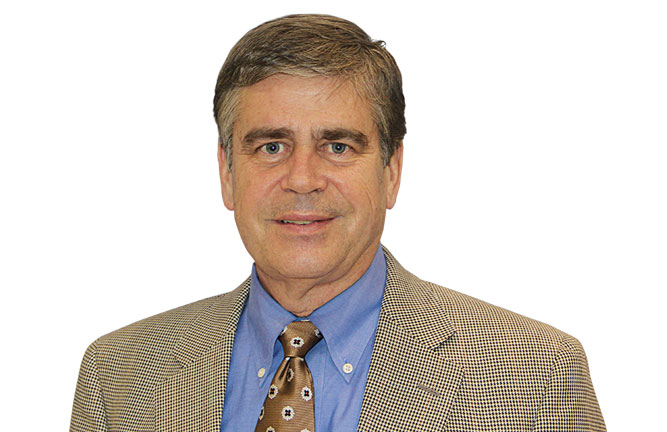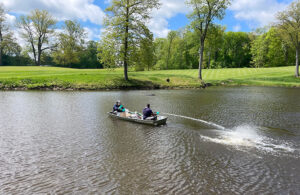The Top Talk Shop
Distinguished university researchers gather for a weed-control symposium to discuss myriad issues
 Bert McCarty makes a point about doveweed during the symposium. (Photo by: Larry Aylward |
Scott McElroy admits he loves controversy. Hence, it was no surprise that McElroy, associate professor of turfgrass and weed science at Auburn University, opened the 2010 Warm-Season Weed-Control Symposium held by Bayer Environmental Science last month talking about a controversial topic — the fate of monosodium methanearsonate, or MSMA.
Ten top turfgrass researchers from various universities in the South gathered in Key Largo, Fla., for the three-day event. The researchers discussed myriad topics, including testing results on two new Bayer ES herbicides — Specticle, which Bayer expects to debut in the fourth quarter; and Celsius, which the company released early this year. The researchers also spoke about key issues affecting the golf course maintenance industry, from controlling Poa annua to researching funding in a tough economy to how to replace MSMA if it is placed on the proverbial shelf.
MSMA, classified as an organic arsenal, is used for weed control in bermudagrass, zoysiagrass and some cool-season turfgrasses. It’s used for post-emergence control of goose-grass, crabgrass and dallisgrass.
There has been much talk the past few years about MSMA’s fate. Some say the herbicide’s days are numbered. Others aren’t so sure.
“I love arguing about it,” McElroy said with a smile.
The big question is what products will be used to replace MSMA to control various Southern weeds if the Environmental Protection Agency does suspend the herbicide.
Shortly into his talk, which focused on MSMA replacement strategies, McElroy reiterated EPA’s stance to cancel MSMA use on golf courses. “After Dec. 31, 2012, registrants are prohibited from selling or distributing existing stocks of products containing MSMA labeled for use on golf courses,” the EPA states in its ruling. “After June 30, 2013, persons other than registrants are prohibited from selling or distributing existing stocks of products containing MSMA labeled for use on golf courses. After Dec. 31, 2013, use of products containing MSMA labeled for all uses, except cotton, is prohibited.”
In 2006, the EPA announced it would cancel re-registration of any pesticides containing MSMA. Arsenic levels raised by MSMA “raise a concern for cancer risk,” the EPA stated. But the organization decided to take a second look at MSMA, partly because it might have overestimated the risk of organic arsenic and MSMA’s contribution to environmental inorganic arsenic levels. Organic arsenic is a naturally occurring element.
In its most recent ruling, McElroy said EPA has written that if someone can prove that arsenic — not organic arsenic, of which MSMA is based — is not toxic, it will reverse the ruling.
“Organic arsenicals … are much safer than elemental arsenics,” McElroy said. “But I’m going on the assumption the EPA will not discover any safety information … so MSMA will go bye-bye.”
But Fred Yelverton, professor of crop science and co-director for the Center for Turfgrass Environmental Research and Education at North Carolina State University, said he’s not convinced MSMA will be eliminated. Yelverton said an EPA official told him the use of existing stocks of MSMA could be extended beyond Dec. 31, 2013.
MSMA’s demise would mean one less herbicide to control at least four weed species in warm-season turf — crabgrass, goosegrass, dallisgrass and broomsedge. Golf course superintendents will also be losing an inexpensive product in MSMA, McElroy pointed out.
The researchers at the meeting agreed that quinclorac and sulfentrazone could be used for crabgrass control, mesotrione for goosegrass control, foramsulfuron for dallisgrass control, among other herbicides. Bayer ES’s two new products can also control the weeds.
McElroy said a post-grass control herbicide was needed. He asked the other researchers if they thought a three-way herbicide could be used for such control.
Yelverton’s presentation focused partly on pre-emergent crabgrass control in tall fescue. Yelverton says improper mowing height — tall fescue is cut too short at 1 or 2 inches — will cause pre-emergent herbicide to not work as well.
“If you raise the mowing height, you will get a lot more crabgrass control,” Yelverton said. “Something as simple as mowing height has a tremendous impact on pre-emergent herbicide efficacy.”
James Brosnan, assistant professor of plant sciences at the University of Tennessee, gave a presentation on the fundamentals of weed germination. Brosnan said three consecutive days and nights with soil temperatures above 55 degrees F will cause crabgrass to emerge.
Brosnan said Poa annua germinates at 44 to 85 degrees F, and that superintendents in Knoxville, Tenn., were having a difficult time controlling Poa annua in the fall. Brosnan said his turf trials show that Bayer’s new herbicide Specticle, which the company expects to register later this year, offers promising in controlling crabgrass and Poa annua. Specticle’s active ingredient is indaziflam.
Don Myers, Bayer ES’s product development manager for herbicides and plant growth regulators, touted indaziflam’s low-use rate, which he said is favorable to the EPA. Yelverton said that fact provides a strong marketing angle for the product.
“Resorts all over the world want to market as being more environmentally friendly — and that includes everything from soap to pesticides,” Yelverton said. “This is a big deal in the golf course industry, and it’s not going away.”
Other presenters included Joe DeFrank, professor of horticulture from the University of Hawaii, who spoke about goosegrass control on Hawaiian golf courses, and Bert McCarty, professor of horticulture at Clemson University, who spoke on doveweed and sedge control. DeFrank talked about mechanical control (verticutting), cultural practices (inducing moisture stress to prevent goosegrass roots from reaching the soil) and chemical control to combat goosegrass. McCarty said doveweed is an up-and-coming problem weed.
“I’ve received more calls on it than any other weed in the past two years,” he added. “We usually don’t see it emerge until about the third week of May.
In closing the event, Matt Bradley, Bayer ES’s herbicide product marketing manager who hosted the symposium, thanked researchers for their time and insights in warm-season grass weed control.
“We appreciate your input,” Bradley told them. “This kind of pulls everything together.”
Until they meet again.












